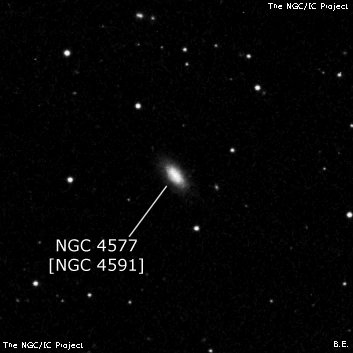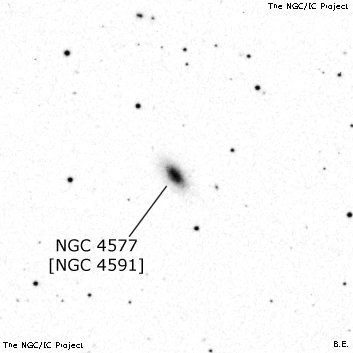NGC/IC Project Restoration Effort
(This is a very very beta version)
NGC4577


Basic Information
Location and Magnitude
Right Ascension: 12:39:12.4
Declination: +6:0:44
Constellation: VIR
Visual Magnitude: 13.2
Historic Information
Discoverer: Herschel W.
Year of discovery: 1784
Discovery aperture: 18.7
Observational
Summary description: vF, vS
Sub-type: Sab
Corwin's Notes
=====
NGC 4577 is possibly WH's first observation of NGC 4591. He saw H III 13
(N4577) only once, and has this to say about it, "A minute before [the
transit of 24 Vir], I suspected a S. neb., but while I took out another piece
to examine it, I lost it again." Dreyer added the comment about the transit
of 24 Virginis, and also noted, "P.D. not taken, clouds. Not seen with
certainty by Bigourdan." N4591 is not the only galaxy in the area that WH
might have seen, but given his position, and the uncertainty in it, it is
perhaps the most likely.
There are some other problems with the observation that deserve mention,
though. First, the star name, 24 Virginis, is no longer used in the
catalogues, and I asked Brent Archinal to dig out the current identification.
The star is actually a duplicate entry for 5 Boo (apparently due to a
reduction error on Flamsteed's part), so does not exist in Virgo at all. That
being the case, there seem to me to be three explanations for Dreyer's comment
about the star: 1) the number is a typo; 2) Dreyer misread WH's observation;
or 3) WH misidentified the star. I think that a typo is unlikely -- the only
stars likely to be seen about the time that WH made the observations are R Vir
or 31 Vir. Getting a typo out of either of those would be difficult. I also
think that an error on Dreyer's part is unlikely -- his work on the NGC and
ICs is clear proof that he rarely made transcription errors. This leaves the
most likely explanation of an identification error by WH.
In any event, the comment about "24 Vir" does not help us much in pinning
down NGC 4577.
Other relevant thoughts and comments: WH's sweep covered a 2 degree wide
strip roughly between +5 deg and +7 deg (1950). The value of the polar
distance in the NGC comes from the GC, but JH does not indicate how he arrived
at it (or the description, "vF, vS"). If we take the polar distance to be
the same as WH's comparison star (11 Vir) for the RA, then the declination
would be 15 arcmin south of the GC and NGC value.
Unfortunately, WH has only one other nebula found the same night, II 26 (which
is probably = NGC 4430 and is discussed under NGC 4453). That is plagued by
similar problems, so offers little help in resolving the case of NGC 4577.
There are no galaxies in any of the places that come from WH's observations,
from GC/NGC, or from attempting to correct WH's RAs using the idea that H II
26 = NGC 4453 (which see) is actually NGC 4430. However, the approximate RA
that we do have, along with the constraints on the declination, point to
either NGC 4580 or NGC 4591 as probably being the object that WH saw. Since
N4580 is H I 124, and N4591 is III 504, the sparce description of N4577
strongly suggests that it is N4591.
Pending a different identification of "24 Vir," I'm going to take N4591 as
the second nebula that WH found on the night of 28 Jan 1784, though with
considerable doubt still attached.
-----
Checking CH's fair copy of the sweep in September 2016 turned up no additional
information. So, the NGC 4591 identity remains the most likely.
Steve's Notes
=====
NGC 4577
See observing notes for NGC 4591. Identification uncertain.



